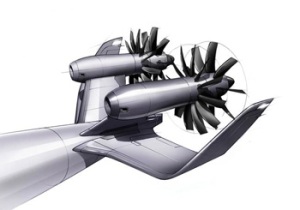May 29 2014
Two aircraft engine concepts, geared turbofan and open rotor, can enable a significant reduction to aircraft fuel consumption.

With open rotor, the potential reduction is 15 per cent. These are the findings of Linda Larsson, who has analysed and evaluated the two concepts.
The average annual increase in passenger kilometres travelled by air has been 5.8% over the last 40 years, and fuel sales have increased by 2.2 per cent annually during the same period. New technological solutions are needed if aviation is to reduce its impact on the climate.
Linda Larsson recently defended her doctoral thesis at Chalmers, where she has been studying two promising aircraft engine concepts.
"They are called geared turbofan and open rotor. The two concepts have a propulsive efficiency; in other words, the energy generated by the core engine can be efficiently converted into thrust," she says.
What differentiates a geared turbofan from a regular turbofan is that the large fan at the front of the engine operates at a lower speed than the turbine that drives it. There is a gearbox between the turbine and fan that reduces the number of revolutions, which enables a lighter turbine and a higher turbine efficiency.
An open rotor engine generates most of the thrust from two counter-rotating propellers instead of a ducted fan. This enables a larger engine diameter and thus a higher propulsive efficiency, without resulting in excessively large and heavy engine nacelle.
"Both of the concepts demonstrated very good potential in terms of reducing fuel consumption: geared turbofan by up to 4 per cent and open rotor by up to 15 per cent. Naturally, though, the technology has to be developed and implemented," says Linda Larsson.
The open rotor concept was studied in the 1980s after the oil crisis and resulting fuel price hikes, and it was apparent already then that it worked. However, fuel prices dropped and the technology lost its appeal. It is now starting to get noticed again.
"The cost of fuel is one of the biggest costs faced by airlines, and there are also obvious environmental reasons and political incentives to reduce fuel consumption and emissions. A great deal of research is being conducted on the open rotor concept right now, and I believe the concept could be in place around 2030," says Linda Larsson.
Her study of the open rotor concept has been conducted on a small aircraft that is a possibility for the future; the small aircraft would operate short routes such as between Gothenburg and Berlin. A method to represent propeller performance was needed in order to do the calculations. Models of this type already exist in the industry but only for specific designs, which means they are not generally accessible. Linda Larsson has instead produced a method that can be used freely and widely and that can be re-scaled as more data becomes available.
The open rotor concept will thus be possible a few years down the road, but geared turbofan applications are not that far away.
"I have studied how great the potential of the architecture itself is. I have not studied any specific models from manufacturers, but aircraft using the geared turbofan concept will be available in the market as early as next year," says Linda Larsson.